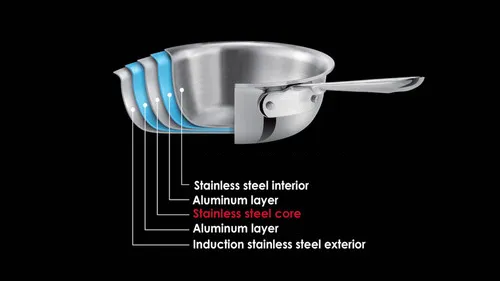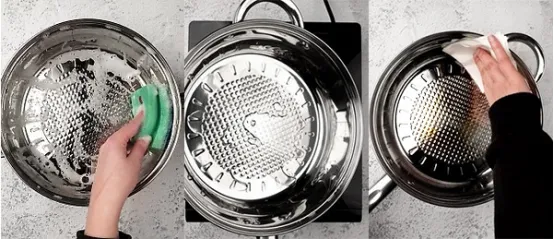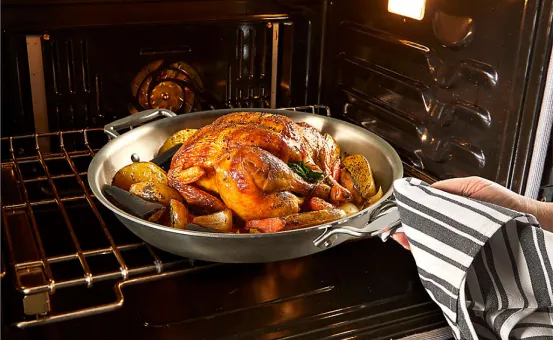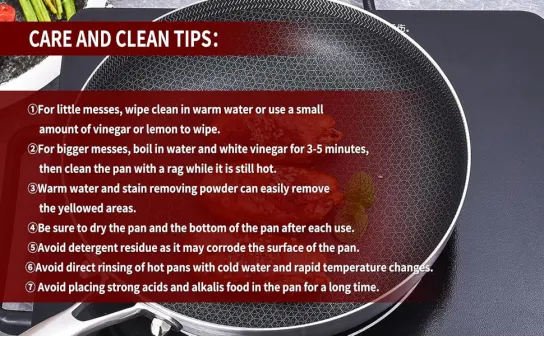
経験豊富なシェフも、料理好きの家庭料理人も、 ステンレス調理器具 は、その耐久性、多用途性、美しさから、人気のある選択となっている。適切な調理器具を選んだからには、調理をより成功させるために、その使い方のガイドラインを探り、理解することも必要です。この記事で オールナイス を使った料理について知っておく必要があることすべてを探る。 ステンレス調理器具.始めよう!
理解する ステンレス調理器具
ステンレス・スチールは鉄を主成分とし、クロムとニッケルの含有量が異なる合金です。この組成により、耐久性、耐腐食性、非反応性に優れ、さまざまな料理に理想的な選択肢となります。アルミニウムや銅などの他の素材に比べ、ステンレス製調理器具は調理中の酸性食品との反応性が低いため、食材本来の風味を保つことができます。

ステンレス製調理器具で調理するための準備
初期クリーニングとシーズニングのコツ
包装やラベルを取り除く:調理器具に、調理の邪魔になったり、不要なガスを発生させたりするような包装やラベルが貼られていないことを確認してください。調理器具は中性洗剤とぬるま湯でよく洗ってください。ステンレス製調理器具の表面を傷つける恐れのある刺激の強い洗剤や研磨剤の使用は避けてください。洗剤と汚れをきれいな水で十分にすすぎ、洗剤が残らないようにします。シェフによっては、最初に使う前に少量の油をフライパンに熱し、ステンレスの表面に焦げ付かないようシーズニングすることを勧めています。この最初のシーズニングは、ステンレス製調理器具の性能を向上させ、食材がこびりつくのを防ぐのに役立ちます。

ステンレス製調理器具の熱伝導率とホットスポットを理解する
ステンレスは熱伝導と保温性が非常に高いため、加熱しすぎた鍋に食材が触れると焦げやすくなります。ステンレス製の調理器具は一般的に熱を均等に分散させることができるため、食材が表面全体で均等に調理され、食材の一部に火が通りすぎたり、加熱不足になったりするのを防ぐことができます。ただし、予熱が適切でないと、ホットスポットが発生することがあります。食材を入れる前に調理器具を予熱しておくと、均一に調理でき、食材が表面にこびりつく可能性も低くなります。
調理ニーズに合ったサイズと形のステンレス調理器具を選ぶ

ステンレス製調理器具のサイズや形状を選ぶことで、より効果的に調理ニーズに応え、より美味しく調理を楽しむことができます。調理器具のサイズは、家族の人数や普段の調理量に合わせて選びましょう。調理したい料理の種類を考えてみましょう。例えば、炒め物には通常、材料を完全に裏返すために大きめの鍋が必要ですし、煮込み料理には深めの鍋が必要かもしれません。 ステンレス・スチール鍋のサイズや形は、調理の習慣やご家庭やレストランの規模によって異なります。
ステンレス製調理器具を使う際の調理のコツ
使用時 炒め物、揚げ物、煮物、焼き物、焙煎用のステンレス製調理器具しかし、いくつかの具体的なヒントや利点は、あなたが最高の調理結果を達成するのに役立ちます。
炒め物と揚げ物:こびりつきを防ぐコツ
- 適切な予熱:ステンレス製調理器具を十分に予熱することで、食材がフライパンにこびりつく可能性を減らすことができる。予熱後に油を入れ、少し煙が出てきたら食材を加える。
- 適切な量のオイルを使う:炒め物や揚げ物の際、適量の油は均一な潤滑層を形成し、食材とフライパンの底が直接接触するのを抑え、こびりつきのリスクを軽減します。
- かき混ぜすぎない:食材がフライパンの底にこびりつく可能性を減らすためにも。
- 熱をコントロールする:ステンレス製の調理器具は熱の伝わりが早く、温度過多による焦げ付きやこびりつきを防ぐため、火加減を調節する必要がある。
茹でる、煮込む:ステンレスの利点を活かす
- 均一な加熱:ステンレススチール製の調理器具は熱を均等に分散させるため、茹でたり煮込んだりするときに特に便利で、食材が表面全体に均等に加熱され、加熱しすぎや加熱不足を防ぐことができる。
- 素材本来の風味を保つ:ステンレス鋼は、通常の使用において食品以外の成分を食品に溶出させないため、特に長時間の調理を必要とする煮込み料理に適しており、素材本来の風味や栄養素を保つことができる。
- 耐久性:ステンレス製調理器具は耐久性に優れ、長時間の高温調理にも耐え、簡単に変形したり割れたりしません。
ベーキングとローストオーブンでのステンレス製調理器具の安全な使い方

- オーブン対応のステンレス製調理器具を使う:また、ステンレス製の調理器具は通常、高温に耐えることができます。
- 調理時間と温度に注意:レシピの指示に従ってオーブンの温度と加熱時間を調節し、食材が均一に加熱され、焦げすぎないようにする。
- 熱絶縁ハンドルを使用する:可能であれば、オーブンから調理器具をより安全に取り出すために、保温性のある取っ手の付いたステンレス製の調理器具を選びましょう。
ステンレス製調理器具のお手入れ方法

ステンレス調理器具をピカピカに保つ正しいお手入れのコツ
ステンレス製調理器具のお手入れには、中性洗剤とぬるま湯をお使いください。ステンレスの表面に傷がついたり腐食したりするのを防ぐため、研磨剤や強い酸性の洗剤の使用は避けてください。ステンレスの表面に傷をつけないよう、洗うときは柔らかい布か非金属のスポンジを選んでください。すすいだ後は、清潔な柔らかい布やペーパータオルでステンレスの表面を拭き、水垢やスケールが残らないようにします。
ステンレス製調理器具の汚れと変色への対応
ステンレスの表面にシミやウロコがついた場合は、ホワイトビネガーやレモン汁で軽く除染することができます。ホワイトビネガーやレモン汁を汚れに塗り、しばらく置いてから柔らかい布で拭いてください。ステンレス製の調理器具は、長時間の高温調理によって変色することがあります。専用のステンレスクリーナーやステンレスケア用品で変色を落としてみてください。また、ステンレス製調理器具を空焚きしたり、推奨温度を超えないようにすることも、表面の変色の可能性を減らすために必要です。
長期的なケアと保管のヒント ステンレス製調理器具用
定期的にステンレスのお手入れ用品や食用油を使い、乾いたステンレスの表面にやさしく塗ることで、輝きを保ち、錆びにくくなります。使用後は調理器具をよく洗い、完全に乾かしてから保管し、湿気の多い場所での保管は避けてください。
概要
ステンレス製調理器具はプロにも家庭のキッチンにも必需品.野菜を炒めたり、ステーキを焼いたり、スープを煮込んだり......ステンレス製の調理器具は、どんな調理法にも適しています。ステンレス製調理器具を使った調理法がわかったところで、シェフお気に入りの調理器具が毎日の料理にどれほどの違いをもたらすか、ステンレス鍋、フライパン、調理器具セットの全商品をご覧ください。同時に ステンレスケータリングサプライヤー 長年に渡り、私たちは豊富な経験を持っています。 カスタマイズ・サービス そして 電子商取引サービスお願いします お問い合わせ をご覧ください。
